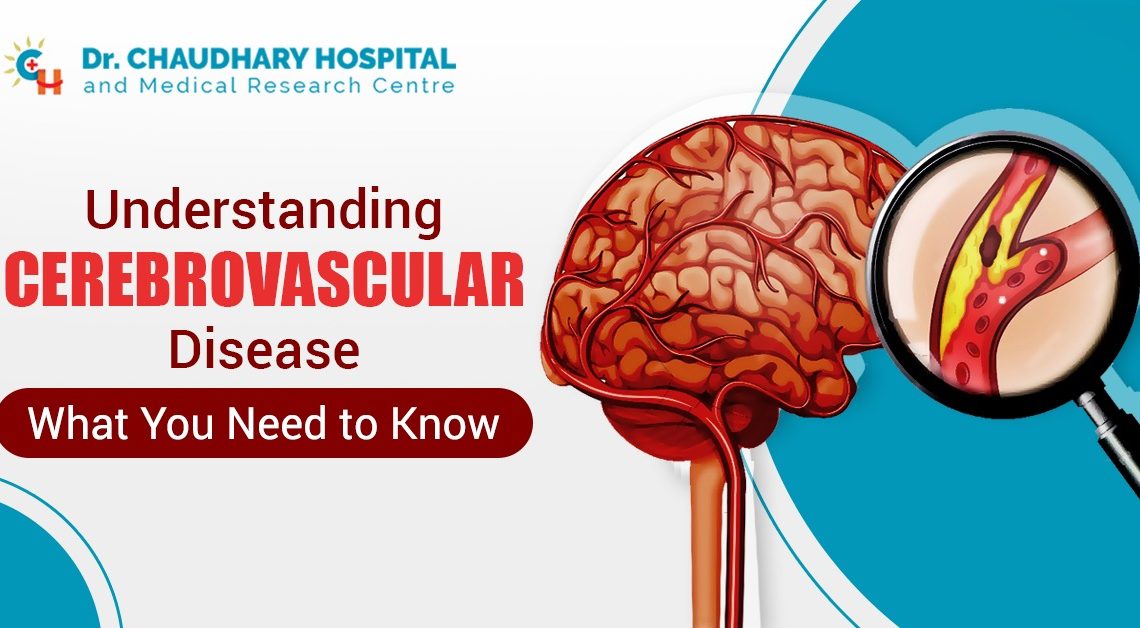Cerebrovascular disease comprises a couple of medical conditions that impact the blood cells and the blood flow in the brain. Constriction of arteries and veins (stenosis), clot formation (thrombosis), artery blockage (embolism), and blood vessel rupture (hemorrhage) can all cause problems with blood flow in the brain. Sometimes, due to a lack of blood flow (also known as Ischemia), it also damages brain tissue and can result in a stroke.
What is Cerebrovascular Disease?
Cerebrovascular disease refers to any disorder that affects the blood vessels and circulation within the brain. The most common forms include ischemic stroke, hemorrhagic stroke, transient ischemic attack (TIA), and cerebral aneurysms. These conditions can result from various factors, including hypertension, diabetes, smoking, obesity, and high cholesterol levels.
Cerebrovascular diseases have the potential to impact both arteries and veins within the brain. The primary cerebral blood vessels that supply blood to the brain that are commonly affected include:
Carotid arteries:
These blood vessels are situated along the front of the neck, with most individuals having one on each side, typically a right and left carotid artery.
Vertebral arteries:
Running along the back of the neck, vertebral arteries are another critical blood vessel group supplying blood to the brain. Similar to carotid arteries, individuals usually possess a right and left vertebral artery.
What are the Potential Causes of Cerebrovascular Disease?
Cerebrovascular disease can arise from various factors, including:
- Formation of a blood clot within a narrow or irregular blood vessel in the brain, known as thrombosis.
- The migration of a blood clot from another part of the body to the brain, termed embolism, often originates from the heart.
- Rupture of a blood vessel in the brain, which typically occurs in association with uncontrolled high blood pressure.
- Accumulation of plaque in the arteries of the brain, a condition known as atherosclerosis.
- Structural abnormalities in the blood vessels of the brain.
- Traumatic brain injury (TBI)
What are the symptoms of cerebrovascular disease?
The symptoms of cerebrovascular disease can differ based on the specific area of the brain affected. Typical symptoms may include:
- Balance issues.
- Confusion or disorientation (delirium).
- Episodes of fainting.
- Vision loss, including visual field impairments or double vision.
- Weakness or paralysis on one side of the body or face.
- Onset of a sudden and intense headache.
- Difficulty speaking or comprehending speech (aphasia).
- Slurred speech (dysarthria).
- Changes in sensation on one side of the body or face.
Diagnosis and Evaluation
Diagnosing cerebrovascular disease typically involves a combination of medical history evaluation, physical examination, imaging tests, and blood tests. Imaging techniques such as CT scans, MRI, and angiography help physicians visualize blood flow, detect blockages, or identify abnormalities in the brain’s blood vessels. These diagnostic tools enable healthcare providers to determine the type and severity of the condition, guiding treatment decisions.
Treatment Approaches
The treatment of cerebrovascular disease depends on the ground cause and the individual’s overall health status. In ischemic strokes, which occur due to blocked blood flow, treatment often involves administering clot-busting medications such as tissue plasminogen activator (tPA) or performing procedures like mechanical thrombectomy to remove the clot. Hemorrhagic strokes, caused by bleeding in the brain, may require surgery to repair damaged blood vessels or relieve pressure on the brain.
For cerebral aneurysms, treatment options include surgical clipping or endovascular coiling to prevent rupture and reduce the risk of bleeding. In some cases, medications may be prescribed to manage underlying conditions such as hypertension and high cholesterol, which contribute to cerebrovascular disease.
- Your doctor may provide you with medical treatment and it may include:
- Blood pressure medications.
- Blood thinners (anticoagulants).
- Cholesterol-lowering drugs.
- Blood sugar medications.
What are the Prevention Strategies?
Preventing cerebrovascular disease involves adopting a healthy lifestyle and managing risk factors effectively. This includes maintaining a balanced diet rich in fruits, vegetables, and whole grains, engaging in regular physical activity, quitting smoking, limiting alcohol consumption, and managing stress levels. Additionally, monitoring and controlling conditions such as hypertension, diabetes, and high cholesterol through medication and lifestyle modifications can significantly reduce the risk of developing cerebrovascular disease. Other preventions include:
- Controlling blood pressure
- Exercise
- Maintain a healthy weight.
- Consult your healthcare provider for regular checkups
- Take a blood thinner if needed for conditions such as heart arrhythmia.
- Weigh the risk of blood clots vs. the benefits of hormone therapy for menopause symptoms
Conclusion
By understanding the causes, symptoms, diagnosis, treatment options, and prevention strategies associated with cerebrovascular disease, individuals can take proactive steps to mitigate risk factors, promote brain health, and improve overall quality of life. By early awareness and education, we can easily navigate the complexities of cerebrovascular disease and work towards healthier futures for ourselves and our communities.


